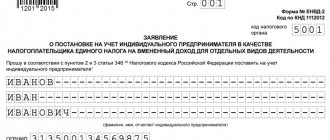Corrective coefficient of basic profitability K2 - essence and purpose
As you can guess from the name, the adjustment coefficient of basic profitability K2 is used along with a second similar indicator to bring the basic profitability, which serves as the basis for calculating the UTII tax base, into a form comparable with existing socio-economic conditions.
For these purposes, two types of coefficients have been introduced by law:
- K1 - regulates profitability depending on changes in inflation and is approved by the government on an annual basis, and therefore should be used by all entities in the Russian Federation;
- K2 - allows you to adapt the size of the tax base to the business environment of a particular region, and therefore the authority to introduce it is transferred to local authorities.
Due to the fact that the range of the second indicator according to clause 7 of Art. 346.29 of the Tax Code of the Russian Federation is limited by numbers from 0.005 to 1, it can be called decreasing. If there is no act in the region establishing its size, it is considered to be equal to 1, and the base is not recalculated downwards.
To determine the size of the UTII taxable object for a month, it is necessary to multiply the basic profitability established for a specific line of business by the coefficients K1 and K2 and by the value of the physical indicator approved for this branch of activity.
How to determine coefficients for a specific LLC or individual entrepreneur
Determining the value of K1 does not present any difficulty. This parameter is assigned once and is valid for the entire subsequent year. Its value is indicated on the official portal of the Ministry of Economic Development, on the websites of information and legal systems, and in the press.
It is a little more difficult to determine the K2 coefficient for UTII for 2020 and 2017. It's all about the “intricacy” of the regulations of local authorities. To determine the exact value of the coefficient, you need to know the following information about your LLC or individual entrepreneur:
- exact direction of activity (OKVED);
- the address of the organization, its affiliation with a specific region and the Federal Tax Service;
- number of hired employees.
The K2 value is an opportunity for local authorities to regulate the tax burden on small businesses. An LLC or individual entrepreneur can use the parameter to optimize expenses for budget payments. You need to choose for conducting activities the area in which the parameter is set at a minimum level.
K1 and K2 for UTII in 2020 are important parameters in the tax calculation formula. Knowing only the basic profitability and the value of the physical indicator, it is impossible to accurately calculate the size of the budget payment. This makes it difficult to choose between imputation, patent, simplified and general taxation systems.
Calculation of K2 UTII 2016, are there any innovations?
The mechanism for calculating the base profitability coefficient K2 2016 is to determine the product of partial coefficients, each of which reflects the impact of a separate factor influencing the procedure for implementing a specific area of business activity in the region. A situation is possible when a partial coefficient is not approved for any criterion, then it is taken equal to 1 and does not affect the final size of the adjustment indicator. The value of the base yield coefficient obtained as a result of the calculation must be rounded to the third decimal place.
The list of possible criteria for assessing the K2 coefficient for UTII for 2016 , given in the Tax Code of the Russian Federation, is not closed and can be expanded by regional legislative bodies at their own discretion, based on the degree of its impact on a certain type of business. Such criteria may include:
- the nature of the surrounding area;
- list of goods available for sale;
- fluctuations in demand;
- state of the logistics system;
- availability of advertising space.
There have been no significant changes in the procedure for determining the K2 coefficient this year compared to previous years. The latest innovations in the Tax Code of the Russian Federation, which occurred in 2014, were limited to the addition of Sevastopol to the list of territories where the establishment of the described indicator by local authorities is allowed.
Economic meaning of the K2 coefficient
The deflator is increasing in nature because its value is always set greater than 1. Its opposite is the K2 coefficient, designed to equalize the conditions under which entrepreneurs from different parts of the country work. It is impossible to compare the revenue of a retail outlet located in Moscow with the income of a store in a small village. To make it profitable for commercial structures throughout Russia to use “imputation”, a local component has been introduced into the tax formula.
K2 for 2020 and UTII 2020 is determined by the authorities of the municipality based on an analysis of the economic situation in the locality. Officials are not required to set it annually, and the value of the indicator may not change for several years. K2 varies from 0.005 to 1. The lower it is, the lower the tax burden on small businesses.
To find out the value of the reduction indicator, you need to contact your local tax office. Another option to get the necessary numbers is to go to your personal account on the website of the Federal Tax Service of Russia: decisions of local councils are posted there. The entrepreneur will be presented with table K2 for UTII for 2020 and 2020, because the value of the coefficient differs for different types of economic activity.
What is the mechanism for approving K2 UTII for 2020 in the regions?
Currently, 92 territorial entities of the Russian Federation have exercised their right to set the level of the K2 correction coefficient. In the capital, on the contrary, the opportunity to use the UTII regime has not been valid since 2014.
Most administrations simultaneously approved both the right of entrepreneurs to use UTII and the mechanism for calculating the second adjustment coefficient. Since this moment, no significant changes have been made to the algorithms. With the exception of isolated cases, most K2 coefficients remain unchanged.
Coefficients used to calculate UTII
Let's talk in more detail about the coefficients used, there are two of them: Deflator coefficient K1 and correction coefficient K2.
Deflator coefficient
The deflator coefficient for 2020 is 1.798. Over the past years, its value has been increasing annually. For example, in 2014 its figure was 1.672.
The deflator coefficient is a value set annually, taking into account changes in the consumer price index for goods and services in the Russian Federation for the previous year, i.e. depends on inflation.
It is calculated as the product of the deflation coefficient for the previous year by the consumer price coefficient in the country in the previous year. The value is set to November 20 for the next year. In the absence of such an order, K1 for the next year remains the same.
| Year | Coefficient K1 for UTII |
| 2017 | 1,798 |
| 2016 | 1,798 |
| 2015 | 1,798 |
| 2014 | 1,672 |
The K1 coefficient for UTII for 2020 was established by Order of the Ministry of Economic Development of the Russian Federation No. 698 dated November 3, 2020.
When calculating tax, the value is increasing.
The procedure for calculating the regional coefficient K2
The size of the territorial entity can have the most significant impact on the procedure for determining the coefficient. Depending on this, a single consolidated adjustment indicator can be introduced or individual for each part of the region or even a city or town.
The regulatory act on the basis of which the coefficient is introduced must provide for its differentiation depending on the field of activity of the companies. The document can use either one adjustment indicator for each direction or a list of several indices on the basis of which it must be calculated depending on:
- territory of business (sometimes including a specific address);
- method of its implementation;
- the nature of the services provided;
- names of the assets used;
- name of the product being sold.
Other conditions may also apply (for example, the number of people with disabilities in the company or the location in the territory where military personnel live). Moreover, the coefficients in different regions, in the presence of similar conditions, very rarely coincide. As an example, here is a special table with final calculations:
| The subject of the Russian Federation | Estimated K2 coefficient in 2020 by business area | ||||||
| Working in the hairdressing business | Furniture repair | Treatment of pets | Service work on vehicles | Freight transportation | Retail sale of products through retail spaces without the right to sell alcoholic beverages | Catering enterprises | |
| UTII K2 2020 Voronezh | 0,75 | 0,75 | 0,5 | 0,7 | 1 | 0,7 | 0,65 |
| K2 UTII 2020 Bryansk region , Gordeevsky district | 0,102 | 0,102 | 0,05 | 0,102 | 0,604 | 0,055 | 1 |
| K2 UTII 2020 Ivanovo | 0,28 | 0,88 | 0,44 | 0,52 | 1 | 0,88 | 1 |
| K2 UTII 2020 Irkutsk | 0,85 | 1 | 1 | 1 | 1 | 0,9 | 1 |
| K2 UTII 2020 Krasnodar | 0,56 | 0,78 | 1 | 0,85 | 1 | 0,46 | 0,78 |
| K2 UTII 2020 Krasnoyarsk | 0,99 | 1 | 1 | 1 | 1 | 0,53 | 0,5 |
| K2 UTII 2020 Moscow region , Kolomna district | 0,6 | 0,6 | 0,2 | 1 | 1 | 0,8 | 0,55 |
| K2 UTII 2020 Nizhny Novgorod , Sormovsky district | 0,23 | 0,19 | 0,2 | 0,9 | 1 | 0,26 | 0,25 |
| K2 UTII 2020 Novosibirsk region , Kochenevsky district | 1 | 1 | 1 | 1 | 1 | 0,24 | 0,24 |
| K2 UTII 2020 St. Petersburg , Balkansky MO | 0,6 | 0,6 | 0,6 | 1 | 1 | 1 | 1 |
| K2 UTII 2020 Saratov region , Ershovsky district | 0,110 | 0,24 | 0,24 | 0,05 | 0,26 | 0,16 | 0,2 |
| K2 UTII 2020 Sverdlovsk region , Baikalovsky district | 0,204 | 0,337 | 0,497 | 0,4 | 1 | 0,27 | 0,036 |
| K2 UTII 2020 Tatarstan , Naberezhnye Chelny | 0,5 | 0,5 | 0,5 | 1 | 1 | 0,7 | 0,5 |
| K2 UTII 2020 Tyumen | 1 | 1 | 1 | 1 | 1 | 1 | 1 |
| K2 UTII 2020 Chelyabinsk | 0,27 | 0,747 | 0,747 | 0,45 | 1 | 0,45 | 0,9 |
| K2 UTII 2020 Yaroslavl | 0,724 | 0,724 | 1 | 1 | 1 | 1 | 1 |
Although the data presented should not be used to calculate tax in a particular region, since they implement the option of calculating the coefficient based on some theoretical set of factors, the table clearly demonstrates how large the difference can be between individual entities.
In this regard, when trying to realize the intention to change the taxation regime to UTII, it is necessary to carefully consider a number of points:
- Carry out a planned calculation of the coefficient using the regional algorithm. To be sure of the result obtained, you can additionally consult with the local branch of the Federal Tax Service, and take practical examples on the inspection website.
- Compare the resulting value with similar data for adjacent areas. It is possible that in one of them the estimated tax amount will be lower and doing business there will be more profitable. There is also a possibility that it is more profitable to switch to a more promising type of activity or to abandon the use of UTII altogether and choose a different procedure for building relations with the state budget.
Despite the fact that most of the issues relating to the use of UTII are approved in the Tax Code of the Russian Federation, regions can influence a significant number of parameters when implementing the tax. One of them is the adjustment coefficient for the basic profitability K2, the calculation rules of which are established, along with other elements of the algorithm for determining the tax base, by local authorities. At the same time, the list of criteria for its introduction is not limited in any way. Before settling on the UTII regime, it is necessary to calculate the specified coefficient and the forecast tax base, and, based on an analysis of the results obtained, make an informed decision.
Similar articles
- Basic profitability of UTII-2018 by type of activity
- Basic yield
- Deflator coefficient for UTII for 2016-2017
- Features and procedure for calculating UTII using an example
- Coefficients K1 and K2 for UTII for 2020
How to calculate K2
The calculation is carried out on the basis of legal documents for each region. In the previously presented document for the Orenburg region, K2 is calculated using the formula:
K2 = AxBxCxDxV, in which the variables have the following values:
A is a variable that takes into account the characteristics of types of economic activity;
B is a variable that takes into account the specifics of conducting activities depending on the type of settlement;
C is a variable that takes into account the size of retail space in retail trade;
D is a variable that takes into account the characteristics of the work of disabled people of groups I and II; parents who support a disabled person living together and requiring constant care since childhood, who do not have employees;
V is a variable that takes into account the range of goods sold in retail trade.
Example.
IP Vilkin A.A. Engaged in retail trade of fruits and vegetables in the city of Orenburg. The store area is 70 square meters. The labor of hired workers is used in the amount of 2 sellers; there are no disabled people or parents of disabled people among the workers. It is necessary to calculate the size of K2 for this case.
K2 = AxBxCxDxV, in which the variables have the following values:
A is a variable that takes into account the characteristics of types of economic activity =1;
B is a variable that takes into account the peculiarities of conducting activities depending on the type of settlement =1;
C is a variable taking into account the size of retail space in retail trade = 0.9;
D is a variable that takes into account the characteristics of the work of disabled people of groups I and II; parents who support a disabled person from childhood who lives together and requires constant care, and who do not have employees = 1;
V is a variable that takes into account the range of goods sold in retail trade = 0.9.
Thus K2=1*1*0.9*1*0.9=0.81
The K2 size for this case is 0.81.
Now let’s calculate the tax amount for the first quarter of 2020: (click to expand)
Tax = 70 (hall area) * 1800 (basic profitability amount) * 1.868 (K1 coefficient) * 0.81 (K2 coefficient) * 3 (number of months) * 0.15 (tax rate) = 85,791 rubles.
Basic concepts ↑
Let us turn to the regulatory documentation, where the definition of K2 is given, and the rules for its use in calculations are established.
What it is?
K2 – adjustment coefficient of basic profitability. It is used to adjust various factors that affect the basic profitability indicators from a certain activity.
This value is taken into account when calculating UTII tax amounts. For example, influencing factors could be:
- season;
- mode of work;
- product range;
- features of the places where the entrepreneur operates;
- area of information fields of the electronic display;
- area of information fields of advertising products used outside buildings;
- number of vehicles;
- amount of profit, etc.
K2 is used together with K1 in calculations in accordance with the procedure of Art. 346.29 Tax Code.
Unlike the deflator coefficient, the adjustment coefficient is a regional value. That is, it is established by local authorities at the municipal and federal levels.
What is his role
The adjustment coefficient is needed in order to create more favorable conditions for business activities in a certain region of the Russian Federation.
K2 indicators may differ for each type of activity and its size depends on several factors.
K2 may reduce the tax base or leave it without any significant changes. Without such a value, it is impossible to calculate the amount of UTII that is payable.
Legal grounds
K2 is installed in accordance with Art. 346.26 clause 3 sub. 3, art. 346.29 clause 6 of the Tax Code.
The size of the coefficient cannot go beyond the limits prescribed by Art. 346.29:
| Bottom frames | 0,005 |
| Upper | 1 |
When filling out sections of the declaration, K2 is reflected in column 090 (section 2). The indicator is approved for an indefinite period.
Although local governments retain the right to adjust the coefficient, which will come into force from the beginning of the year.
The documentation that establishes K2 comes into force no earlier than 30 days after its publication and no earlier than the first day of the next tax period (clause 1 of Article 5 of the Tax Code).
In order for the new coefficient indicators to be applied from the beginning of the new calendar year, the legislative act is published by the authorities no later than December 1. current year.
In the event that the established value worsens the situation of imputed tax payers or it is published later than December 1, then the decision will come into force a year later.
For example, if a document is published on December 17, 2020, K2 will come into force on January 1, 2020.
The rules of application for individual entrepreneurs and organizations with the status of a legal entity are the same, and are specified in paragraph 4 of Art. 5, paragraph 7 art. 346.29 Tax Code, Letter of the Ministry of Finance dated 05/08/08 No. 03-11-04/3/233 and dated 04/2/08 No. 02-7-11/110.






